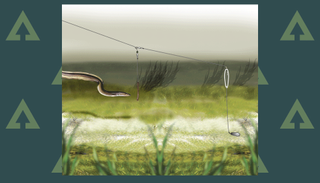Why the Dyson rig is the best rig for eel fishing
Summer is eel fishing time for more and more specialist anglers, as they try and catch a personal best.

Welcome to Advnture, the new home of AnglersMail.co.uk
Here we bring you a classic eel rig called the Dyson rig, named after the late specialist angler Colin Dyson.
The Dyson version shown below was used by Angler’s Mail magazine writer Gary Newman during a feature that produced fish to over 5 lb, but he’s caught bigger ones too. Why not give it a try yourself?

Here’s what Gary had to say about it…
“I set up two Dyson rigs (see the rig diagram, to see how it is constructed) as I knew that with suspended baits hanging downwards, rather than popped-up, they were pretty much crayfish resistant, as the previous year I’d still had a bait on every time I‘d wound in.
With this rig it is essential not to tighten down too much, otherwise the float is dragged towards the bottom, but also not to allow too much slack, otherwise the lobworm can fall to the bottom where those hungry crays are waiting.
By using a reasonable size bobbin, in terms of weight, it is possible to get the rig balanced just right. You know when it is set right because if you pull the bobbin down it will slowly creep back up as the buoyancy of the float takes line back as it pops back up.
Advnture Newsletter
All the latest inspiration, tips and guides to help you plan your next Advnture!
Having everything so finely balanced also helps to exaggerate any bites, and the rig is pretty resistance-free, especially if you can get hold of some ceramic rod ring inners to use as run rings.
In the past I have always preferred to fish open bale arms for any species where resistance can cause them to drop the bait, but last winter I experimented with using Baitrunners on their loosest setting for zander and didn’t experience any increase in dropped runs. In fact, although not as resistance-free as an open bale arm, I think a Baitrunner actually offers more of a constant resistance and is less jerky.
My hook links are made from 50 lb Korda Arma-Kord braid, which I much prefer to wire as it is more supple, and I have yet to be bitten off on it even when I have accidentally hooked pike.
This trace is fished about a foot long and a size 6 ESP T6 hook, which has a nice wide gape, is attached to it. I thread a lobworm onto the hook up the shank so it is nice and neat, with plenty of the point showing.
The distance from the bottom that the bait is presented is determined by how far up the lead link you set your stop knot.”
A popular alternative to the Dyson rig is the John Sidley rig, named after the late West Midlands eel specialist. You can find that rig and other eel fishing advice on the National Anguilla Club website.
